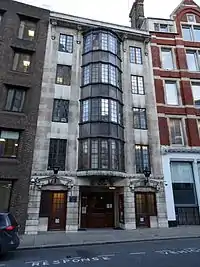Saracen's Head, London
The Saracen's Head was an inn on the north side of the street to the west of the church of St Sepulchre-without-Newgate in Snow Hill, London.[1]

History
The inn dated from the Middle Ages, when it was a coaching inn.[2] The origins of the name, "Saracen's Head", are uncertain. It became a popular stop for mail coaches approaching the City of London as it provided a place for passengers to rest. It featured a large gateway that led into a courtyard with numerous galleries leading into individual bedrooms.[3] In 1522, Charles V, Holy Roman Emperor, stayed at the inn, by which time it had 30 beds and could stable four horses.[1][2]
Samuel Pepys and Jonathan Swift were reported to be regular patrons at the inn. In the 18th century, the Mohocks kidnapped several elderly women at the inn, trapped them in barrels, and rolled them downhill towards Newgate Street.[4] During the 19th century, there were three signs on each side of the inn with a picture of a Saracen.[2] The inn was mentioned in Charles Dickens' Nicholas Nickleby, referencing two of the signs that adorned the courtyard gateway, and is where Nickleby first meets the schoolmaster Wackford Squeers.[2][5]
The Saracen's Head was demolished in 1868 to construct the Holborn Viaduct.[6] The landlord was subsequently arrested for attempting to sell spirits in an adjoining property following the inn's closure, as his licence had been revoked.[7] There is a plaque noting the inn on the current premises.[8]
A song about the inn appears in the The Flying Inn.[9][10]
References
Citations
- Henry A Harben, 'Sandy's Row – Savage's Rents', in A Dictionary of London (London, 1918), British History Online [accessed 21 September 2020].
- Weinreb et al. 2008, p. 822.
- Walter Thornbury, 'St. Sepulchre's and its neighbourhood', in Old and New London: Volume 2 (London, 1878), pp. 477–491. British History Online http://www.british-history.ac.uk/old-new-london/vol2/pp477-491 [accessed 18 September 2020].
- Glinert 2004, p. 50.
- Wolfreys, Julian (2012). "Life and death: Snow Hill, The Saracen's Head, Smithfield, Saint James's Parish, Saint Sepulchre's Church". Dickens's London. Edinburgh: Edinburgh University Press. pp. 120–121. ISBN 978-0-7486-4040-9.
- Allibut, Robert (1977). Rambles in Dickens' Land. p. 56. ISBN 978-1-465-52023-4.; Wheatley, Henry Benjamin (2011) [1891]. London Past and Present: Its History, Associations, and Traditions. p. 210. ISBN 978-1-108-02808-0.
- ""Police". The Times. 21 March 1868. p. 11. Retrieved 22 September 2020 – via The Times Digital Archive.
- "Saracen's Head". London Remembers. Retrieved 22 September 2020.
- Chesterton, G. K. (2013). The Flying Inn. Courier Corporation. p. 34. ISBN 978-0-486-14706-2.
- Thomas C. Peters (1994). Battling for the Modern Mind: A Beginner's Chesterton. CPH. p. 27. ISBN 978-0-570-04664-6.
Sources
- Glinert, Ed (2004). The London Compendium: A Street-by-street Exploration of the Hidden Metropolis. Penguin. ISBN 978-0-141-01213-1.CS1 maint: ref=harv (link)
- Weinreb, Ben; Hibbert, Christopher; Keay, John; Keay, Julia (2008). The London Encyclopaedia (3rd ed.). Pan Macmillan. ISBN 978-1-405-04924-5.